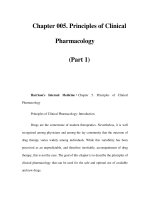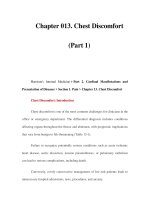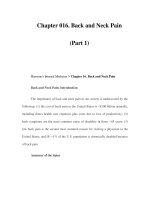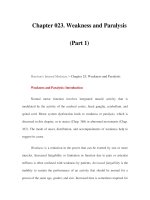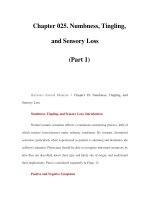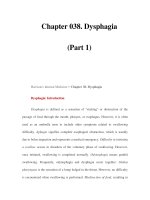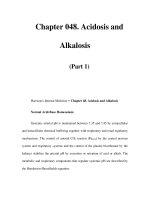Endoscopic Extraperitoneal Radical Prostatectomy - part 1 pps
Bạn đang xem bản rút gọn của tài liệu. Xem và tải ngay bản đầy đủ của tài liệu tại đây (585.89 KB, 20 trang )
J U. Stolzenburg • Matthew T. Gettman • Evangelos N. Liatsikos (Eds.)
Endoscopic Extraperitoneal Radical Prostatectomy
Laparoscopic and Robot-Assisted Surgery
J U. Stolzenburg • M. T. Gettman • E. N. Liatsikos (Eds.)
With 197 Figures and 10 Tables
Endoscopic
Extraperitoneal
Radical Prostatectomy
Laparoscopic and Robot-Assisted Surgery
123
Stolzenburg, Jens-Uwe, MD, FRCS (Ed)
Professor and Chairman
Department of Urology
Head of International Training
Centre of Urologic Laparoscopy
University of Leipzig
Liebigstraße 20
04103 Leipzig, Germany
e-mail:
Gettman, Matthew T., MD
Associate Professor
Department of Urology
Mayo Clinic
Gonda 7S, 200 1st Street SW
Rochester, MN 55905, USA
e-mail:
Liatsikos, Evangelos N., MD, PhD
Assistant Professor of Urology
Department of Urology
University of Patras, School of Medicine
26500 Rio, Patras, Greece
e-mail:
Library of Congress Control Number: 22007934520
ISBN-978-3-540-45533-2 Springer Berlin Heidelberg New York
This work is subject to copyright. All rights are reserved, whether the whole or part of the material is concerned,
specifically the rights of translation, reprinting, reuse of illustrations, recitation, broadcasting, reproduction on micro-
film or in any other way, and storage in data banks. Duplication of this publication or parts thereof is permitted only
under the provisions of the German Copyright Law of September 9, 1965, in its current version, and permissions for
use must always be obtained from Springer. Violations are liable for prosecution under the German Copyright Law.
Springer is a part of Springer Science + Business Media
springer.com
© Springer-Verlag Berlin Heidelberg 2007
The use of general descriptive names, registered names, trademarks, etc. in this publication does not imply,
even in the absence of a specific statement, that such names are exempt from the relevant protective laws and
regulations and therefore free for general use.
Product liability: The publishers cannot guarantee the accuracy of any information about dosage
and application contained in this book. In every individual case the user must check such information
by consulting the relevant literature.
Medical Editor: Dr. Ute Heilmann, Heidelberg, Germany
Desk Editor: Dörthe Mennecke-Bühler, Heidelberg, Germany
Cover design: Frido Steinen-Broo, eStudio Calamar, Spain
Reproduction and Typesetting: am-productions GmbH, Wiesloch, Germany
Production: L
E
-TEX Jelonek, Schmidt & Vöckler GbR, Leipzig, Germany
Printed on acid-free paper 27/3100 – YL – 5 4 3 2 1 0
Foreword
Minimally invasive interventions were a source of
controversy as early as the beginning of the 1960s in
stone removal. A group of young, aggressive urolo-
gists gradually shortened the standard approach to
the kidney to a few centimetres, developed special in-
struments for this purpose, and entered into competi-
tion with the general surgeons who were carrying out
cholecystectomies via mini-incisions. The arguments
– shortening hospital stay, decreasing the need for
postoperative pain therapy – were the same, until
PNL and ESWL achieved better results.
Age and experience have always been the enemies
of progress, but this did not prevent the development
of laparoscopic techniques in urology, beginning with
the detection of cryptorchid testes and retroperito-
neal lymphadenectomy. Ten years ago I counselled
one of my most dextrous pupils to avoid laparoscopy.
He ignored my advice and is now one of the most
sought-after urologists in Belgium.
In the evolution of surgical techniques the wheel of
history has often rolled backwards. The widespread
use of clamps in intestinal surgery is perhaps one of
the most instructive examples of a broad return to
conventional techniques, with the newer methods be-
coming restricted to particular indications.
It is only natural to mistrust a new technique – in
this case EERPE – that one cannot perform oneself.
In the field of laparoscopy the investment in robots
is so immense that a retreat in the foreseeable future
seems unlikely. In the USA – the land of unlimited
opportunities – robot-assisted radical prostate sur-
gery has become one of the financial pillars of 500
urological clinics, with up to three operations per day.
It thus seems likely that industry will exert more in-
fluence than ever on the diffusion of laparoscopic
techniques.
Word of mouth, however, remains the strongest in-
fluence on individual patients, who gravitate to the
centres where satisfaction is highest. Distance and
time play an ever-decreasing role in their decisions.
The Centre of Urologic Laparoscopy at the Univer-
sity of Leipzig is among the leading institutions
in terms of numbers of patients treated, and is peer-
less in the number of courses offered each year
and the number of participants. This book is thus a
product of 10 years’ experience of performing and
teaching EERPE. All that has been learned is con-
tained between its covers.
The reader just needs to glance at the chapter on
topographical anatomy to become enthralled by the
innovative three-dimensional functional depiction of
the pelvic organs and their internal innervation. The
computer-aided portrayal sets new standards for the
future. The succinct text clearly outlines what we al-
ready know and what remains to be discovered.
The same is true for all the other chapters. Particu-
lar mention should be made of the unrivalled depth of
focus of the photographs and Gottfried Müller’s ex-
cellent illustrations.
In contrast to other books on this topic, a chapter
is dedicated to the prevention and management of
complications.
The editors and authors are to be congratulated on
a splendid volume. The effort invested in anatomical
studies, illustrations and animal experiments exceeds
by far that in other comparable titles.
Mainz, March 2007
R. Hohenfellner
Preface
Endoscopic/laparoscopic extraperitoneal radical prost-
atectomy has been established in the literature as an
intriguing therapeutic option for the management of
carcinoma of the prostate. Endoscopic and robotic
approaches have proved to be equally effective for the
management of localized prostate cancer. Nerve-
sparing endoscopic/laparoscopic and robotic radical
prostatectomy should aim to maintain sexual func-
tion and restore continence early after surgery with-
out impairing the final oncological outcome.
The advent of laparoscopy and robotics has revital-
ized the discussion pertaining to the anatomy of the
structures surrounding the prostate gland. Despite
the different approaches for radical prostatectomy the
key to better results is full understanding of the anat-
omy of the prostate, the bladder neck and the urethra.
A special chapter has thus been devoted to the anato-
my of the prostate and its surrounding structures.
There is a plethora of urology textbooks describing
laparoscopic procedures in different ways. The pres-
ent book is more an atlas than a conventional text-
book. Our main goal is to guide the urologist step by
step through the procedure, aiming to make this
highly standardized technique reproducible. Every
procedure is presented with numerous endoscopic
images and diagrams so that the reader can fully
comprehend the different surgical steps. Complica-
tions and useful tips and tricks for their management
are described in detail.
We would like to thank Jens Mondry and Gottfried
Müller for their significant contributions with regard
to computer imaging and design creation, respective-
ly. Furthermore, we would like to express our grati-
tude to all contributing authors for their significant
scientific input.
Jens-Uwe Stolzenburg
Matthew T. Gettman
Evangelos N. Liatsikos
Contents
1 History of Laparoscopy, Endoscopic
Extraperitoneal Radical Prostatectomy
and Robotic Surgery .............. 1
1.1 Historical Aspects of Laparoscopy and
Endoscopic Extraperitoneal Radical
Prostatectomy ................. 3
Stefanos Papadoukakis, Dirk Kusche,
Michael C. Truss
1.2 Historical Overview of Robotic Radical
Prostatectomy ................. 7
Matthew T. Gettman, Hubert John
2 Surgical Anatomy
for Radical Prostatectomy ......... 11
2.1 Surgical Neuroanatomy
of the Male Pelvis .............. 13
ilo Schwalenberg, Rudolph Hohenfellner,
Jochen Neuhaus, Matthias Winkler,
Evangelos N. Liatsikos,
Jens-Uwe Stolzenburg
2.2 Inter- and Intrafascial Dissection
Technique of Nerve-sparing Radical
Prostatectomy ..............
.. 20
Jens-Uwe Stolzenburg, Jochen Neuhaus,
ilo Schwalenberg,
Katharina Spanel-Borowski, Sabine Löer,
Rudolph Hohenfellner,
Evangelos N. Liatsikos
2.3 The Muscular Systems
of the Bladder Neck and Urethra ..... 24
Jens-Uwe Stolzenburg, Jochen Neuhaus,
Lars-Christian Horn, Evangelos N. Liatsikos,
ilo Schwalenberg
3 Equipment for Endoscopic
Extraperitoneal Radical Prostatectomy . 31
3.1 Recommended Set of Instruments
for Endoscopic Extraperitoneal
Radical Prostatectomy ........... 33
Jens-Uwe Stolzenburg
3.2 Advances in Image Processing ....... 37
Torsten Lüdtke, Christine Senet
4 Indications for Endoscopic
Extraperitoneal Radical Prostatectomy . 39
Jens-Uwe Stolzenburg, Evangelos Liatsikos,
Lars-Christian Horn, Michael C. Truss
5 Anaesthesia Considerations
in Radical Prostatectomy .......... 49
Fritjo Koenig, Bernd Aedtner,
Markus Wehner, Robert Rabenalt,
Paraskevi Katsakiori, Kriton Filos,
Evangelos N. Liatsikos,
Jens-Uwe Stolzenburg
6 Pelvic Lymphadenectomy in the
Management of Prostate Cancer ..... 55
Sivaprakasam Sivalingam, H. Schwaibold
7 Technique of Endoscopic Extraperitoneal
Radical Prostatectomy – Step by Step .. 65
Jens-Uwe Stolzenburg, Robert Rabenalt,
Minh Do, Evangelos Liatsikos
8 Troubelshooting .............. 121
Jens-Uwe Stolzenburg, Minh Do,
Robert Rabenalt, Anja Dietel,
Heidemarie Pfeier, Frank Reinhardt,
Michael C. Truss, Evangelos Liatsikos
9 Haemostasis in Radical
Prostatectomy ............... 135
Evangelos N. Liatsikos, Paraskevi Katsakiori,
Jens-Uwe Stolzenburg
10 Extraperitoneal Robotic Radical
Prostatectomy: Operative Technique –
Step by Step ................. 143
Hubert John, Matthew T. Gettman
11 The Need for Classication
of Complications of Radical
Prostatectomy ............... 161
Jens-Uwe Stolzenburg, Paraskevi Katsakiori,
Minh Do, Robert Rabenalt,
Panagiotis Kalidonis, ilo Schwalenberg,
Alan McNeil, Evangelos N. Liatsikos
12 Modular Training in Endoscopic
Extraperitoneal Radical Prostatectomy 169
Jens-Uwe Stolzenburg, Robert Rabenalt,
Minh Do, Michael Truss,
Shiv Mohan Bhanot, Hartwig Schwaibold,
Kossen Ho, Chris Anderson, Alan McNeill,
Paraskevi Katsakiori, Evangelos N. Liatsikos
13 Postoperative Management ....... 179
13.1 Inpatient Rehabilitation
of Post-Prostatectomy Incontinence .. 181
S. Homann, W. Homann, U. Otto
13.2 Rehabilitation of Erectile Function
After Radical Prostatectomy ....... 187
Klaus-Peter Jünemann
Contents
X
List of Contributors
Aedtner, Bernd, Dr. med.
Department of Anaesthesiology
and Intensive Care Medicine
University of Leipzig
Liebigstraße 20
04103 Leipzig, Germany
Anderson, Chris, MD
Consultant , Department of Urology
St Georges Hospital
London, UK
Bhanot, Shiv Mohan, MD
Consultant , Department of Urology
King George Hospital
London, UK
Dietel, Anja, Dr. med.
Department of Urology
University of Leipzig
Liebigstraße 20
04103 Leipzig, Germany
Do, Hoang Minh, Dr. med.
Department of Urology
University of Leipzig
Liebigstraße 20
04103 Leipzig, Germany
Filos, Kritos, MD
Associate Professor, Department of Anaesthesiology
and Intensive Care Medicine
University of Patras
26500 Rio, Patras, Greece
Gettman, Matthew T., MD
Associate Professor
Department of Urology
Mayo Clinic
Gonda 7S, 200 1st Street SW
Rochester, MN 55905, USA
Ho, Kossen, MD
Hong Kong Urology Clinic
510 Central Building, Pedder Street
Hong Kong, China
Hoffmann, Susanne, Dr. med.
Clinic Quellental
Wiesenweg 6
34537 Bad Wildungen, Germany
Hoffmann, W., Dr. med.
Clinic Quellental
Wiesenweg 6
34537 Bad Wildungen, Germany
Hohenfellner, Rudolf, Prof. Dr. med. em.
Department of Urology
University of Mainz
Saarstraße 21
55122 Mainz, Germany
Horn, Lars-Christian, Prof. Dr. med.
Institute of Pathology
University of Leipzig
Liebigstraße 13
04103 Leipzig, Germany
List of Contributors
XII
John, Hubert Andreas, PD Dr. med.
Department of Urology
Clinic Hirslanden
Witellikerstraße 40
8008 Zürich, Switzerland
Jünemann, Klaus-Peter, Prof. Dr. med.
Chairman, Department of Urology
University of Kiel
Olshausenstraße 40
24118 Kiel, Germany
Kallidonis, Panagiotis, MD
Department of Urology
University of Patras
26500 Rio, Patras, Greece
Katsakiori, Paraskevi, MD
Department of Urology
University of Patras
26500 Rio, Patras, Greece
König, Fritjoff, Prof. Dr. med.
Department of Anaesthesiology
and Intensive Care Medicine
University of Leipzig
Liebigstraße 20
04103 Leipzig, Germany
Kusche, Dirk, Dr. med.
Department of Urology
Klinikum Dortmund gGmbH
Beurhausstraße 40
44137 Dortmund, Germany
Liatsikos, Evangelos N., MD, PhD
Assistant Professor
Department of Urology
University of Patras
26500 Rio, Patras, Greece
Loeffler, Sabine, Dr. rer. nat.
Institute of Anatomy
University of Leipzig
Liebigstraße 13
04103 Leipzig, Germany
Luedtke, Torsten
Olympus Optical Co. (Europa) GmbH
Wendenstraße 14–18
20097 Hamburg, Germany
McNeil, Alan, BmedSci, FRCS (Ed & Eng),
FRCS (Urol)
Consultant, Department of Urology
Western General Hospital
Crewe Road
Edinburgh, EH4 2XU, UK
Neuhaus, Jochen, Dr. rer. nat.
Department of Urology
University of Leipzig
Liebigstraße 20
04103 Leipzig, Germany
Otto, U., Prof. Dr. med.
Clinic Quellental
Wiesenweg 6
34537 Bad Wildungen, Germany
Papadoukakis, Stefanos, MD
Department of Urology
Klinikum Dortmund gGmbH
Beurhausstraße 40
44137 Dortmund, Germany
Pfeiffer, Heidemarie, Dr. med.
Department of Urology
University of Leipzig
Liebigstraße 20
04103 Leipzig, Germany
Rabenalt, Robert, Dr. med.
Department of Urology
University of Leipzig
Liebigstraße 20
04103 Leipzig, Germany
Schwaibold, Hartwig, Dr. med.
Chairman, Department of Urology
Kliniken am Steinenberg
Steinenbergstraße 25
72764 Reutlingen, Germany
Schwalenberg, Thilo, Dr. med.
Department of Urology
University of Leipzig
Liebigstraße 20
04103 Leipzig, Germany
Senet, Christine
Olympus Optical Co. (Europa) GmbH
Wendenstraße 14–18
20097 Hamburg, Germany
Sivalingam, Sivaprakasam, MD
Southmead Hospital
Bristol, UK
Spanel-Borowski, Katharina, Prof. Dr. med.
Chairman, Institute of Anatomy
University of Leipzig
Liebigstraße 13
04103 Leipzig, Germany
Stolzenburg, Jens-Uwe, Prof. Dr. med.
Chairman, Department of Urology
Head of International Training Centre
of Urologic Laparoscopy
University of Leipzig
Liebigstraße 20
04103 Leipzig, Germany
List of Contributors
XIII
Truss, Michael C. , Prof. Dr. med.
Chairman, Department of Urology
Klinikum Dortmund gGmbH
Beurhausstraße 40
44137 Dortmund, Germany
Wehner, Markus, Dr. med.
Department of Anaesthesiology
and Intensive Care Medicine
University of Leipzig
Liebigstraße 20
04103 Leipzig, Germany
Winkler, Matthias, MD
Consultant, Department of Urology
Chairing Cross Hospital
Fulham Palace Road
London, W6 8RF, UK
List of Abbreviations
a external iliac artery
aw abdominal wall
bl bladder
bm bladder mucosa
bn bladder neck
bo bladder outlet
bp bulb of penis
bu bulbourethalis glands (Cowper’s glands)
ca common iliac artery
dl detrusor lamellae
dv Denonvillier’s fascia
ef endopelvic fascia
ev epigastric vessels
ia internal iliac artery
iv internal iliac vein
la levator ani muscle
nvb neurovascular bundle
oe obturator externus muscle
oi obturator internus muscle
p prostate
pb pubic bone
pc prostatic capsule
pf periprostatic fascia
pg prostate glands
pl puboprostatic ligament
pln pelvic lymph nodes
pp prostate pedicle
pt peritoneum
r rectum
rm rectus muscle
sc spermatic cord
sp Santorini plexus
sv seminal vesicle
u urethra
ul urethral lumen
ur ureter
us urethral sphincter
v external iliac vein
va (superior) vesical artery
vd vas deferens
vs vesical sphincter
Contents
1.1 Historical Aspects of Laparoscopy
and Endoscopic Extraperitoneal
Radical Prostatectomy . . . . . . . . . . . . . . . . . . . . . . . . . . 3
Stefanos Papadoukakis, Dirk Kusche,
Michael C. Truss
1.1.1 History of Laparoscopy . . . . . . . . . . . . . . . . . . . . . . . . . 3
1.1.2 Laparoscopic Radical Prostatectomy . . . . . . . . . . . . 4
1.1.3 Extraperitoneal Access – The Term “EERPE” . . . . . 5
References . . . . . . . . . . . . . . . . . . . . . . . . . . . . . . . . . . . . . . 6
1.2 Historical Overview of Robotic Radical
Prostatectomy . . . . . . . . . . . . . . . . . . . . . . . . . . . . . . . . . 7
Matthew T. Gettman ∙ Hubert John
References . . . . . . . . . . . . . . . . . . . . . . . . . . . . . . . . . . . . . 8
History of Laparoscopy, Endoscopic
Extraperitoneal Radical Prostatectomy
and Robotic Surgery
1
the standard approach due to ongoing technical and
technological refinements in laparoscopy.
Almost at the same time, Schuessler et al. reported
the first laparoscopically performed lymphadenecto-
my for prostate cancer [10]. For many urologists, this
procedure was the first and most intriguing insight
into the world of laparoscopy.
Laparoscopic ligation of the spermatic veins for
varicocele is a widely performed procedure and a
good training opportunity to help urologists famil-
iarize themselves with the laparoscopic instruments
and the laparoscopic reality. The translation of the
two-dimensional monitor picture into three-dimen-
sional movement of the surgeon’s hands has a certain
learning curve, and varicocele ligation is considered
as an “entry” or training procedure for more complex
operations.
Historical Aspects of Laparoscopy
and Endoscopic Extraperitoneal
Radical Prostatectomy
Stefanos Papadoukakis ∙ Dirk Kusche ∙ Michael C. Truss
1.1
1.1.1 History of Laparoscopy
“Laparoscopy“ is derived from two Greek words
meaning “flank” and “insight.” Laparoscopy is the
established term although „celioscopy“, meaning in-
traabdominal insight, would have been more accu-
rate. Today “laparoscopy” describes a procedure dur-
ing which contents of the intraperitoneal cavity or of
the extraperitoneal space are examined and manipu-
lated in a diagnostic or therapeutic intervention.
Although the term has been widely used in urology
only in the past 15 years, the concept is actually more
than 100 years old. It was at the beginning of the 20th
century that Kelling experimentally insufflated the
abdominal cavity of a dog and inserted a cystoscope
to inspect the abdominal visceral organs [6] (Figs. 1.1.1,
1.1.2).
Urology began to embrace laparoscopy as an essen-
tial diagnostic procedure in the early 1970s. By that
time urologists had started using laparoscopy to search
for undescended cryptorchid testes that were en-
trapped in the abdominal cavity, anywhere along their
route from the retroperitoneal space to the scrotum.
The status of laparoscopy in urology did not change
dramatically in the following decade and it was al-
ways a diagnostic procedure only. It was not until the
1990s that two reports described another, more ad-
vanced use of laparoscopy in our specialty.
Clayman et al., in 1991, reported the first laparo-
scopically performed nephrectomy with simultane-
ous intracorporeal tissue morcellation and use of im-
permeable specimen sacs to permit organ removal
through the endoscopic ports [2]. Some doubted
whether morcellation of the kidney was an adequate
method for organ removal in an oncologic setting.
The first hand-assisted nephrectomy was described
by Nakada and colleagues in 1997 and this has re-
mained an alternative approach to radical nephrec-
tomy [7]. Nowadays, radical nephrectomy has become
Fig. 1.1.1 Georg Kelling (1866–1945): the man who introduced
modern laparoscopy into medicine
Chapter 1.1
St. Papadoukakis ∙ D. Kusche ∙ M. C. Truss
1
4
The modern laparoscopic era has evolved dramati-
cally over the course of the past decade. It is a world-
wide reality that almost every single urologic opera-
tion, oncologic or otherwise, can be performed
laparoscopically just as efficiently, and with fewer and
less serious complications, as with conventional open
surgery. UPJ reconstruction, retroperitoneal lymphad-
enectomy, radical nephrectomy with vena cava throm-
bus extraction, live donor nephrectomy during renal
transplantation, radical prostatectomy, even radical
cystectomy with continent diversion – from minor to
major operations, urologists have managed to incor-
porate laparoscopy into everyday urologic practice.
The future is promising and exciting. The advent of ro-
botic technologies and robot-assisted surgery, with
and without tactile feedback, is already a reality in
modern urological practice. Nevertheless, there is cur-
rently not enough evidence to show that these tech-
niques indeed provide advantages over “conventional”
laparoscopy, either in functional or in oncological out-
comes. Furthermore, it has not yet been possible to
demonstrate that robot-assisted surgery is cost effec-
tive.
1.1.2 Laparoscopic Radical Prostatectomy
As mentioned above, Schuessler and coworkers were
the first to perform laparoscopic lymphadenectomy
for prostate cancer prior to open radical prostatecto-
my [10]. The same group described removal of the
seminal vesicles during laparoscopic lymphadenec-
tomy [5]. In 1992 this group was the first to perform
transperitoneal laparoscopic radical prostatectomies,
and they published their initial series of 9 patients in
1997 [9]. They were not enthusiastic about the tech-
nique and concluded that “ laparoscopy is not an ef-
ficacious surgical alternative to open prostatectomy
for malignancy ” This team was not able to define a
clear advantage of laparoscopic surgery over the tra-
ditional open radical retropubic prostatectomy re-
garding hospital stay, continence and reconvales-
cence. It is noteworthy that these first operations
lasted almost 9 h on average, which was considered a
major drawback for the further development of the
technique.
Raboy et al. described the first extraperitoneal rad-
ical prostatectomy and, in contrast to the Schuessler
group, they were rather satisfied with the results of
the new evolving technique [8].
In December 1997 Guilloneau and colleagues per-
formed a transperitoneal laparoscopic radical prosta-
tectomy in less than 6 h, and in January 1998 the same
team started to perform their first series of laparo-
scopic radical prostatectomy [3, 4]. Laparoscopic rad-
ical prostatectomy soon became a widespread mini-
mally invasive alternative to radical prostatectomy, so
that by the year 2001 more than 1,200 radical prosta-
tectomies had been performed, mainly in European
centers. Ever since then a rapidly increasing number
of urologic departments, both in Europe and the USA,
have performed large series of this innovative mini-
mally invasive technique. Many urologists have sug-
gested various modifications of the original opera-
tion, including transperitoneal or extraperitoneal
approach, antegrade or retrograde dissection and dif-
ferent neurovascular bundle-sparing techniques.
Over the past few years, laparoscopic radical pros-
tatectomy has become the standard procedure for the
treatment of localized prostate cancer in an increas-
ing number of urologic centers in Europe and in the
USA.
The well-known advantages of minimally invasive
surgery over conventional open surgery have led to
increasing interest worldwide in the further develop-
Fig. 1.1.2 e Kelling apparatus (cystoscope with insuation
to inspect the abdominal cavity in a dog
Chapter 1.1
5
Historical Aspects of Laparoscopy
ment of laparoscopy in urology. These benefits in-
clude less postoperative pain, a shorter hospital stay,
and faster resumption of normal activities along with
a minimally invasive technique that provides better
visualization of the operative field through the optic
magnification, shorter catheterization time and min-
imal intraoperative blood loss. To the aforementioned
advantages we have to add the fact that laparoscopic
radical prostatectomy is oncologically just as efficient
as the traditional open retropubic prostatectomy and
has similar or better functional results in experienced
hands.
In a recent survey in Germany, 35% of laparoscopi-
cally active departments already performed laparo-
scopic prostatectomy and almost all of the rest in-
tended to introduce in the near future [19].
1.1.3 Extraperitoneal Access –
1.1.3 The Term “EERPE”
The first laparoscopic prostatectomies described were
performed using transperitoneal access. Despite the
fact that the extraperitoneal route was almost simul-
taneously reported [8], the French team at the Mont-
souris center chose to develop the transperitoneal ap-
proach [4].
The groups in France refined and evolved the tech-
nique and reduced operation time to 3–4 h, not much
more than a third of the time initially reported by
Schuessler. Later on the French experience spread
throughout Europe.
However, general skepticism persisted due to the
fact that an extraperitoneal organ, the prostate, was
being accessed by a transperitoneal route with possi-
ble intraperitoneal complications: bowel injuries, in-
traperitoneal bleeding, ileus, intraperitoneal leakage
of urine, and acute infection of the peritoneal cavity
are considered the main short-term or intraoperative
complications, while intraperitoneal adhesion forma-
tion and subsequent chronic bowel obstruction with
recurrent ileus are the principal long-term complica-
tions.
The perspective of an extraperitoneal approach to
the prostate was developed after the initial report by
Raboy and coworkers. The first series of 42 patients to
undergo extraperitoneal radical prostatectomy was
published by Bollens et al. in 2001 [1].
The extraperitoneal approach to radical prostatec-
tomy bears the advantages of a minimally invasive
technique for the removal of the prostate while over-
coming the limitations of a transperitoneal approach
(i.e., potential problems in visualization, and in-
creased risk of intra- and postoperative intraperito-
neal complications).
A further development of the technique was re-
ported by Stolzenburg et al. as EERPE in 2002 [11].
The term endoscopic extraperitoneal radical prosta-
tectomy (EERPE) was used to describe the totally ex-
traperitoneal access to the prostate for radical prosta-
tectomy. Based on the growing experience with this
technique, the same group has proposed many modi-
fications and improvements of this operation, includ-
ing a standardized and reproducible nerve-sparing,
potency-preserving approach [18]. Furthermore, pres-
ervation of the puboprostatic ligaments for better
early postoperative continence rates, minimal blood
loss, and the reliable oncologic results (regarding pos-
itive margins) have made this approach the standard
and first option for the treatment of localized prostate
cancer in many specialized centers [13, 14]. EERPE is
an ever-evolving procedure. The latest technique in-
volves intrafascial preparation of the prostate leaving
the pelvic fascias intact [15]. This approach reflects
the latest anatomical studies identifying neurovascu-
lar structures not only dorsolateral to the prostate but
also within the prostatic fascia laterally and anterolat-
erally.
In contrast to “traditional” thinking, there are al-
most no limiting factors for minimally invasive radi-
cal prostatectomy and especially for EERPE. Previous
abdominal or pelvic surgery, for example, is no bar-
rier. Modifications of trocar placement and operative
techniques have made EERPE possible even for pa-
tients considered unsuitable for minimally invasive
surgery in the past [12, 16, 17].
It is of paramount importance to point out that the
evolution of the technique has been assisted by ad-
vances in medical equipment and instruments. In the
past few years the development of devices such as en-
doscopic clip applicators, harmonic scalpels and en-
doscopic multiple-use instruments, as well as two-
component sealants, has promoted minimal invasive
surgery in urology.
Today it is clear that EERPE has already reached (if
not, indeed, surpassed) the standards of open radical
prostatectomy. One of the major problems that many
urologists face is the long and steep learning curve of
laparoscopic procedures. Therefore, a new modular
training concept has been developed for EERPE in or-
Chapter 1.1
St. Papadoukakis ∙ D. Kusche ∙ M. C. Truss
1
6
der to standardize the surgical training and shorten
the learning curve of both laparoscopically experi-
enced and laparoscopically naive surgeons [16].
In summary, today EERPE is a first-line option for
patients with localized prostate cancer in a rapidly in-
creasing number of urologic departments around the
globe. Innovative developments such as EERPE, to-
gether with cutting-edge technological advances, en-
able urology to remain in the forefront of medical and
technical development.
References
1. Bollens R, Van den Bosche M, Roumeguere T et al (2001)
Extraperitoneal laparoscopic radical prostatectomy: re-
sults aer 50 cases. Eur Urol 40:65–69
2. Clayman RV, Kavoussi LR, Sopper NJ et al (1991) Laparo-
scopic nephrectomy: initial case report. J Urol 146:278
3. Guilloneau B, Vallancien G (2000) Laparoscopic radical
prostatectomy: the Montsouris technique. J Urol 163:1643
4. Guilloneau B, Rozet F, Cathelineau X, Vallancien G et al
(2002) Perioperative complications of laparoscopic radical
prostatectomy: the Montsouris 3 year experience. J Urol
167:51–56
5. Kavoussi LR, Schuessler WW, VancaillieTG, Clayman RV
(1993) Laparoscopic approach to the seminal vesicles. J
Urol 150:417–419
6. Kelling G (1923) Zur Colioskopie. Arch Clin Chir 126:226
7. Nakada SY, Moon TD, Gist M et al (1997) Use of a Pneumo
Sleeve as an adjunct in laparoscopic nephrectomy. Urology
49:612
8. Raboy A, Ferzli G, Albert P (1997) Initial experience with
extraperitoneal endoscope radical retropubic prostatec-
tomy. Urology 50:849–853
9. Schuessler WW, Schulam PG, Clayman RV et al (1997)
Laparoscopic radical prostatectomy: initial short term ex-
perience. Urology 50:854
10. Schuessler WW, Vancaillie TG, Reich H et al (1991) Trans-
peritoneal endosurgical lymphadenectomy in patients
with localized prostate cancer. J Urol 145:988
11. Stolzenburg JU, Do M, Pfeier H et al (2002) e endo-
scopic extraperitoneal radical prostatectomy (EERPE):
technique and initial experience. World J Urol 20:48–55
12. Stolzenburg JU, Ho K, Do M, Rabenalt R, Dorschner W,
Truss M (2005) Impact of previous surgery on endoscopic
extraperitoneal radical prostatectomy. Urology 65:325–331
13. Stolzenburg JU, Liatsikos EN, Rabenalt R, Do M, Sakela-
ropoulos G, Horn LC, Truss MC (2006) Nerve sparing en-
doscopic extraperitoneal radical prostatectomy – eect of
puboprostatic ligament preservation on early continence
and positive margins. Eur Urol 49:103–112
14. Stolzenburg JU, Rabenalt R, Do M, Ho K, Dorschner W,
Waldkirch E, Jonas U, Schützt A, Horn L, Truss M (2005)
Endoscopic extraperitoneal radical prostatectomy: onco-
logical and functional results aer 700 procedures. J Urol
174:1271–1275
15. Stolzenburg JU, Rabenalt R, Tannapfel A, Liatsikos E
(2006) Intrafascial nerve sparing endoscopic extraperito-
neal radical prostatectomy. Urology 67:17–21
16. Stolzenburg JU, Schwaibold H, Bhanot S, Rabenalt R, Do
M, Truss M, Ho K, Anderson C (2005) Modular surgical
training for endoscopic extraperitoneal radical prostatec-
tomy. BJU Int 96:1022–1027
17. Stolzenburg JU, Truss M, Bekos A, Do M, Rabenalt M,
Stief C, Hoznek A, Abbou CC, Neuhaus J, Dorschner W
(2004) Does the extraperitoneal laparoscopic approach
improve the outcome of radical prostatectomy? Curr Urol
Rep 5:115–122
18. Stolzenburg JU, Truss MC, Do M, Rabenalt R, Pfeier H,
Dunzinger M, Aedtner, Stief CG, Jonas U, Dorschner W
(2003) Evolution of endoscopic extraperitoneal radical
prostatectomy (EERPE) – technical improvements and
development of a nerve-sparing, potency-preserving ap-
proach. World J Urol 21:147–152
19. Vogeli TA, Burchard M, Fornara P et al (2002) Laparoscop-
ing working group of the German Urological Association.
Current laparoscopic practice patterns in urology: results
of a survey among urologists in Germany and Switzerland.
Eur Urol 42:441–446
The development of minimally invasive laparoscopic
techniques has had a profound impact on urology in
the past decade. Despite the numerous patient-related
advantages of many minimally invasive procedures,
laparoscopic techniques are often more difficult to
perform than corresponding tasks in open surgery.
Indeed, the technical learning curve for minimally
invasive laparoscopic techniques can be very steep.
Laparoscopy can impose limitations on instrument
manipulation (secondary to trocar positioning), dex-
terity (secondary to long non-articulated instru-
ments), tissue palpation (lack of haptic interface), and
vision (two-dimensional on flat screen). Robotic sur-
gery has been developed to increase operative preci-
sion, decrease the learning curve, and thereby in-
crease clinical applicability of minimally invasive
laparoscopic techniques. Since the introduction of
surgical robots, a rapid technologic evolution has
been witnessed in urology [1, 2].
The first clinically available surgical robot in urol-
ogy was purposely designed to hold a laparoscope [3].
This robot, called the Automated Endoscope System
for Optimal Positioning (AESOP, Intuitive Surgical,
Sunnyvale, CA), has one robotic arm with six degrees
of freedom (DOF) that is directly mounted on the op-
erating table [3, 4]. The robot is controlled using a foot
pedal, joystick, or voice commands. Kavoussi et al.
noted that AESOP improved image quality and elimi-
nated the need for surgical assistants during a variety
of laparoscopic procedures, including ureterolysis,
pelvic lymphadenectomy, nephrectomy, and pyelo-
plasty [3]. Recently, Antiphon et al. demonstrated the
feasibility of laparoscopic radical prostatectomy (RP)
performed with the use of a single surgeon, self-re-
taining retractors, and AESOP [5]. The introduction
of AESOP also facilitated the development of tele-
mentoring and teleproctoring, which have also made
laparoscopic surgery more applicable [6].
Building on the foundations of the AESOP robot,
more advanced robotics systems have been intro-
duced clinically within the past 5 years. These robots
were derived from experimental robotic systems de-
veloped in the early 1990s [7, 8]. More advanced ro-
bots, also known as master–slave robots, have a re-
mote control unit that is used to control multiple
robotic instruments and camera arms. Using mas-
ter–slave robots, surgeons use hand controls to ma-
neuver three or four mechanical arms placed inside
the patient [1, 2]. All surgical movements are en-
hanced and replicated by the robot. For instance, the
robot can potentially improve performance by filter-
ing away physiologic tremors. One of the first systems
was introduced by Bowersox and Cornum for open
surgery [7]. The system used three-dimensional im-
aging and interchangeable surgical instruments posi-
tioned on two mechanical arms. Another innovative
telerobot with tactile feedback (i.e. haptic interface)
was similarly introduced by Schurr et al. with favor-
able experimental results [8].
From a historical standpoint, the Zeus robot (In-
tuitive Surgical, Sunnyvale, CA) was one of the first
master–slave robots to be introduced clinically [1, 2].
When initially introduced, the robot lacked three-di-
mensional vision capability as well as articulated in-
strumentation. Given the design deficiencies, another
robotics system called da Vinci has emerged as the
leading telerobot to date in the operating room.
The da Vinci robotic system (Intuitive Surgical,
Mountain View, CA) is also a master–slave robot that
includes two or three robotic instrument arms, a
camera arm, a standard three-dimensional imaging
system, and a remote control unit [1, 2]. Since FDA
approval of the initial da Vinci robot, more advanced
versions of this system have been introduced [9]. For
example, the so-called fourth-arm da Vinci robot re-
duces reliance on assistants when performing robotic
surgery. The latest robot, called the da Vinci S, incor-
Historical Overview
of Robotic Radical Prostatectomy
Matthew T. Gettman ∙ Hubert John
1.2
Chapter 1.2
M. T. Gettman ∙ H. John
1
8
porates the fourth-arm features as well as other fea-
tures to potentially make the system easier to use for
the surgeon and assistants.
Using a da Vinci robot, manipulator arms are at-
tached to the patient via reusable laparoscopic ports
and the camera arm is placed through a standard tro-
car [1, 2]. Da Vinci instruments have limited reusabil-
ity, but are designed to replicate wrist motions by pro-
viding six DOF and grip. Over the years, da Vinci
instrumentation has improved substantially to more
closely parallel instruments used in pure laparoscopic
or open surgery. Images with da Vinci are viewed
with high magnification, but da Vinci systems lack a
force-feedback feature, require cumbersome robotic
installation, can impair intraoperative communica-
tion, and are associated with high financial cost. In
part, the additional costs of da Vinci are related to re-
quired use of interchangeable instruments with lim-
ited reusability [10]. Upon attaching the instrument
to the robotic arm, the system automatically subtracts
„life“ from the instrument.
Similar to conventional laparoscopy, a learning
curve is also present with telerobotics. The robotic
learning curve is thought, however, to be much less
steep than that of conventional laparoscopy [1, 2].
Technical factors that must be overcome include op-
erating preferentially with visual cues and operating
with high magnification. The learning curve is also
related to the teamwork between the remotely seated
surgeon and the assistants sterilely scrubbed at the
operating table.
Robotic surgical techniques have been developed
experimentally and clinically for a wide variety of ap-
plications in the upper and lower urinary tract [11–
19]. Although telerobotic nephrectomies and adrenal-
ectomies have been reported, robotic indications in
the upper tract have favored reconstructive versus ex-
tirpative procedures. Since the clinical description in
2002, robotic pyeloplasty has been increasingly per-
formed for ureteropelvic junction obstruction [15]. In
the lower urinary tract, telerobots are most common-
ly utilized for RP, but other procedures such as radical
cystectomy and urinary diversion are gaining mo-
mentum [16, 17].
Initial experience with da Vinci for laparoscopic
RP was described predominantly at centers with sig-
nificant experience in non-robotic laparoscopic RP or
open RP [11, 18–20]. Since that time, interest in ro-
botic prostatectomy has increased exponentially. The
technique of robotic prostatectomy is standardized
using either a transperitoneal or an extraperitoneal
approach [11, 18–20]. Data comparing the results of
da Vinci RP, open RP, and pure laparoscopic RP sug-
gest that the robotic technique is at the very least
equivalent to the other techniques at short-term fol-
low-up [19]. Ongoing evaluation of outcomes data is
required to further understand the clinical advantag-
es of robotic prostatectomy in comparison to other
prostatectomy techniques.
In summary, robotic surgery has rapidly developed
in urology. For many urologic problems in the upper
and lower urinary tract, a standardized approach
with a surgical robot is considered a bona fide treat-
ment option. At the present time, robotic surgery in
urology is most commonly used for RP. The technique
is increasingly being successfully embraced by sur-
geons with or without prior experience in laparoscopy
using either a transperitoneal or an extraperitoneal
approach. Longer follow-up and analysis of outcomes
data is needed to confidently determine safety of all
robotic procedures. Nonetheless, robotics does ap-
pear established in urology and is expected to con-
tinue to have a favorable evolution and impact on fu-
ture generations of surgeons with improved
telecommunications, imaging, computer technolo-
gies, miniaturization, and the advent of virtual reali-
ty.
References
1. Gettman MT, Blute ML, Peschel R, Bartsch G (2003) Cur-
rent status of robotics in urologic laparoscopy. Eur Urol
43:106–112
2. Gettman MT, Cadeddu JA (2004 ) Robotics in urologic
surgery. In: Graham SD (ed) Glenn‘s urologic surgery,
6th edn. Lippincott Williams & Wilkins, Philadelphia, pp
1027–1033
3. Kavoussi LR, Moore RG, Partin AW, Bender JS, Zenilman
ME, Satava RM (1994) Telerobotic assisted laparoscopic
surgery: initial laboratory and clinical experience. Urol-
ogy 44:15–19
4. Partin AW, Adams JB, Moore RG, Kavoussi LR (1995)
Complete robot-assisted laparoscopic urologic surgery: a
preliminary report. J Am Coll Surg 181:552–557
5. Antiphon P, Hoznek A, Benyoussef A, et al (2003) Com-
plete solo laparoscopic radical prostatectomy: initial expe-
rience. Urology 61:724
6. Janetschek G, Bartsch G, Kavoussi LR (1998) Transcon-
tinental interactive laparoscopic telesurgery between the
United States and Europe. J Urol 160:1413
7. Bowersox JC, Cornum RL (1998) Remote operative urol-
ogy using a surgical telemanipulator system: preliminary
observations. Urology 52:17–22
Chapter 1.2
9
Historical Overview of Robotic Radical Prostatectomy
8. Schurr MO, Buess G, Neisius B (2000) Robotics and tele-
manipulation technologies for endoscopic surgery: a re-
view of the ARTEMIS project. Surg Endosc 14:375–381
9. Esposito MP, Ilbeigi P, Ahmed M, Lanteri V (2005) Use
of fourth arm in daVinci robot-assisted extraperitoneal
laparoscopic prostatectomy: novel technique. Urology
66:649–652
10. Lotan Y, Cadeddu JA, Gettman MT (2004) e new eco-
nomics of radical prostatectomy: cost comparison of
open, laparoscopic and robot assisted techniques. J Urol
172:1431–1435
11. Abbou CC, Hoznek A, Salomon L, Olsson LE, Lobontiu
A, Saint F, Cicco A, Antiphon P, Chopin D (2001) Lapa-
roscopic radical prostatectomy with remote controlled ro-
bot. J Urol 165:1964–1966
12. Gill IS, Sung GT, Hsu TH, Meraney AM (2000) Robotic
remote laparoscopic nephrectomy and adrenalectomy:
initial experience. J Urol 164:2082–2085
13. Guillonneau B, Jayet C, Tewari A, Vallancien G (2001)
Robot assisted laparoscopic nephrectomy. J Urol 166:200–
201
14. Bentas W, Wolfram M, Brautigam R, Binder J (2002) Lap-
aroscopic transperitoneal adrenalectomy using a remote
controlled robotic surgical system. J Endourol 16:373–376
15. Gettman MT, Neururer R, Bartsch G, Peschel R (2002)
Anderson-Hynes dismembered pyeloplasty performed us-
ing the daVinci robotic system. Urology 60:509–513
16. Hubert J, Chammas M, Larre S, et al (2006) Initial expe-
rience with successful totally robotic laparoscopic cysto-
prostatectomy and ileal conduit construction in tetraple-
gic patient: report of two cases. J Endourol 20:139–143
17. Shah NL, Hemal AK, Menon M (2005) Robot-assisted
radical cystectomy and urinary diversion. Curr Urol Rep
6:122–125
18. Binder J, Kramer W (2001) Robotically-assisted laparo-
scopic radical prostatectomy. BJU Int 87:408–410
19. Menon M, Tewari A, Baize B, Guillonneau B, Vallancien G
(2002) Prospective comparison of radical retropubic pros-
tatectomy and robot-assisted anatomic prostatectomy: the
Vattikuti Urology Institute experience. Urology 60:864–
868
20. Gettman MT, Hoznek A, Salomon L, et al (2003) Laparo-
scopic radical prostatectomy: description of the extraperi-
toneal approach using the daVinci robotic system. J Urol
170:416–419

